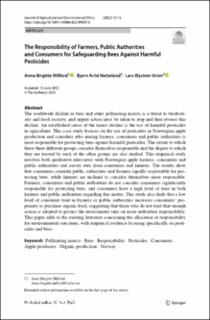| dc.contributor.author | Milford, Anna Birgitte | |
| dc.contributor.author | Hatteland, Bjørn Arild | |
| dc.contributor.author | Ursin, Lars Øystein | |
| dc.date.accessioned | 2022-10-11T08:15:31Z | |
| dc.date.available | 2022-10-11T08:15:31Z | |
| dc.date.created | 2022-08-09T10:43:16Z | |
| dc.date.issued | 2022-07-13 | |
| dc.identifier.citation | Journal of Agricultural and Environmental Ethics. 2022, 35 (3), 1-22. | en_US |
| dc.identifier.issn | 1187-7863 | |
| dc.identifier.uri | https://hdl.handle.net/11250/3025288 | |
| dc.description.abstract | The worldwide decline in bees and other pollinating insects is a threat to biodiversity and food security, and urgent action must be taken to stop and then reverse this decline. An established cause of the insect decline is the use of harmful pesticides in agriculture. This case study focuses on the use of pesticides in Norwegian apple production and considers who among farmers, consumers and public authorities is most responsible for protecting bees against harmful pesticides. The extent to which these three different groups consider themselves responsible and the degree to which they are trusted by each of the other groups are also studied. This empirical study involves both qualitative interviews with Norwegian apple farmers, consumers and public authorities and survey data from consumers and farmers. The results show that consumers consider public authorities and farmers equally responsible for protecting bees, while farmers are inclined to consider themselves more responsible. Farmers, consumers and public authorities do not consider consumers significantly responsible for protecting bees, and consumers have a high level of trust in both farmers and public authorities regarding this matter. This study also finds that a low level of consumer trust in farmers or public authorities increases consumers’ propensity to purchase organic food, suggesting that those who do not trust that enough action is adopted to protect the environment take on more individual responsibility. This paper adds to the existing literature concerning the allocation of responsibility for environmental outcomes, with empirical evidence focusing specifically on pesticides and bees. | en_US |
| dc.description.abstract | The Responsibility of Farmers, Public Authorities and Consumers for Safeguarding Bees Against Harmful Pesticides | en_US |
| dc.language.iso | eng | en_US |
| dc.publisher | Springer Nature | en_US |
| dc.rights | Navngivelse 4.0 Internasjonal | * |
| dc.rights.uri | http://creativecommons.org/licenses/by/4.0/deed.no | * |
| dc.title | The Responsibility of Farmers, Public Authorities and Consumers for Safeguarding Bees Against Harmful Pesticides | en_US |
| dc.title.alternative | The Responsibility of Farmers, Public Authorities and Consumers for Safeguarding Bees Against Harmful Pesticides | en_US |
| dc.type | Peer reviewed | en_US |
| dc.type | Journal article | en_US |
| dc.description.version | publishedVersion | en_US |
| dc.rights.holder | © The Author(s) 2022 | en_US |
| dc.source.pagenumber | 1-22 | en_US |
| dc.source.volume | 35 | en_US |
| dc.source.journal | Journal of Agricultural and Environmental Ethics | en_US |
| dc.source.issue | 3 | en_US |
| dc.identifier.doi | 10.1007/s10806-022-09889-0 | |
| dc.identifier.cristin | 2041897 | |
| dc.relation.project | Norges forskningsråd: 268273 | en_US |
| dc.source.articlenumber | 13 | en_US |
| cristin.ispublished | true | |
| cristin.fulltext | original | |
| cristin.qualitycode | 1 | |

